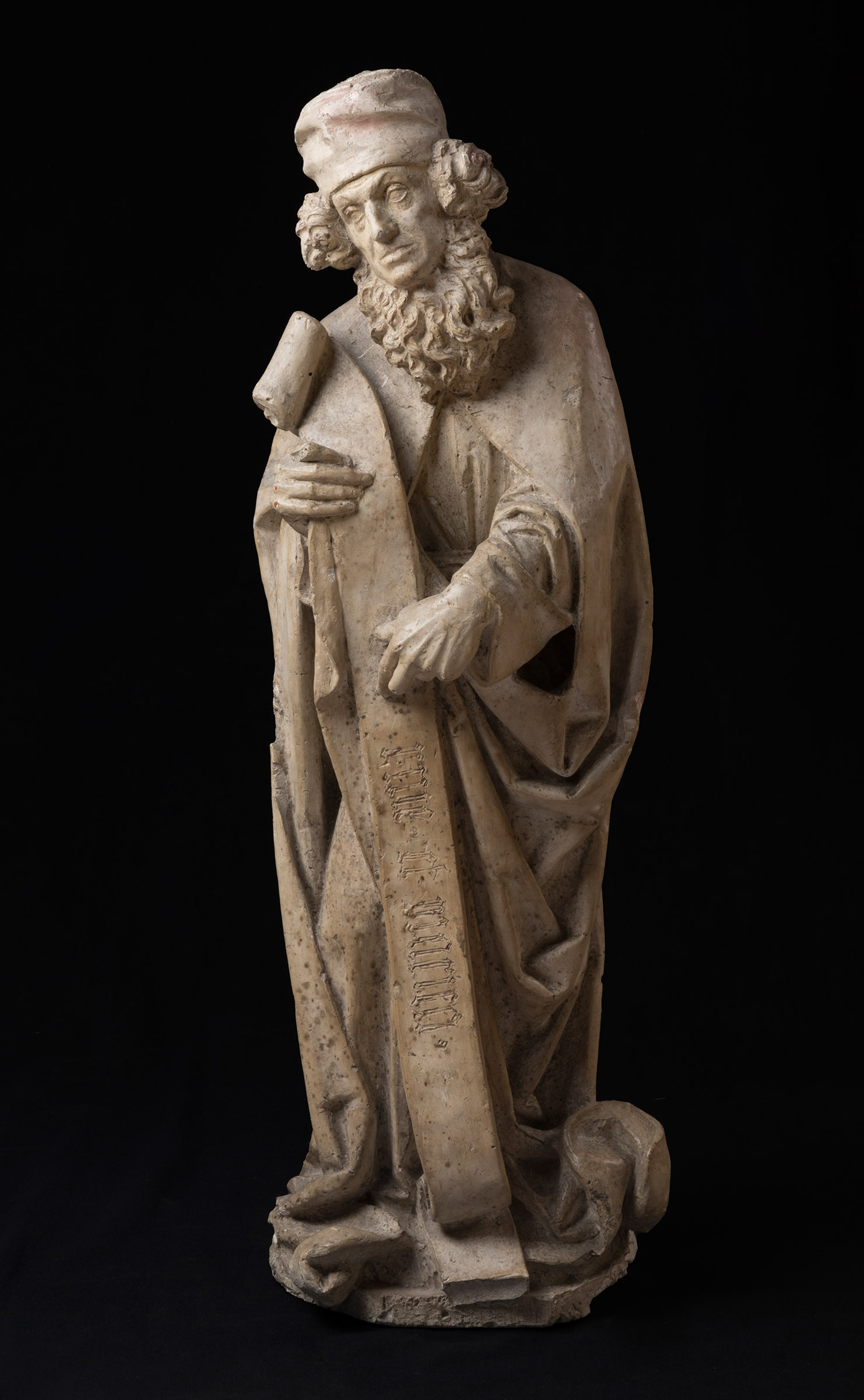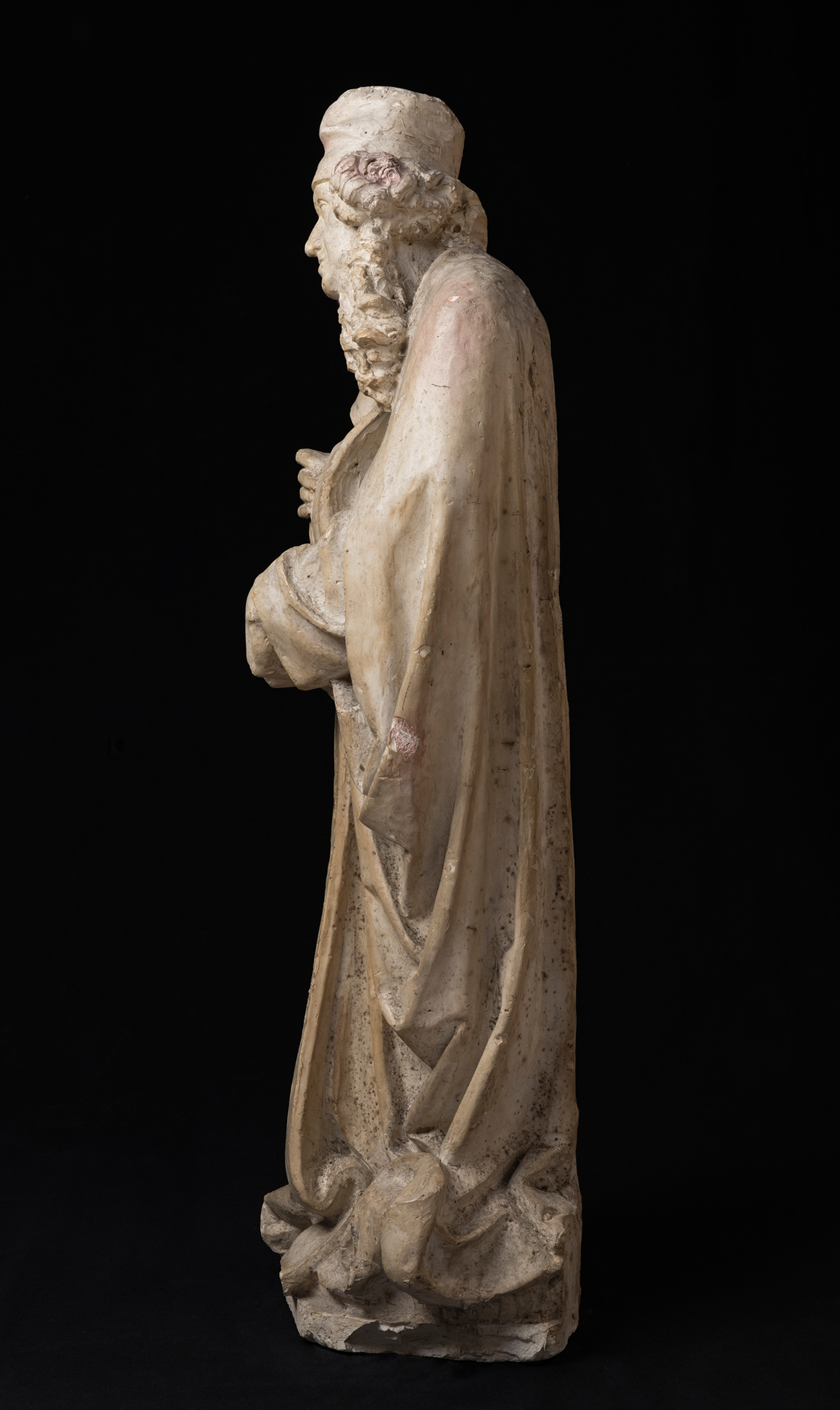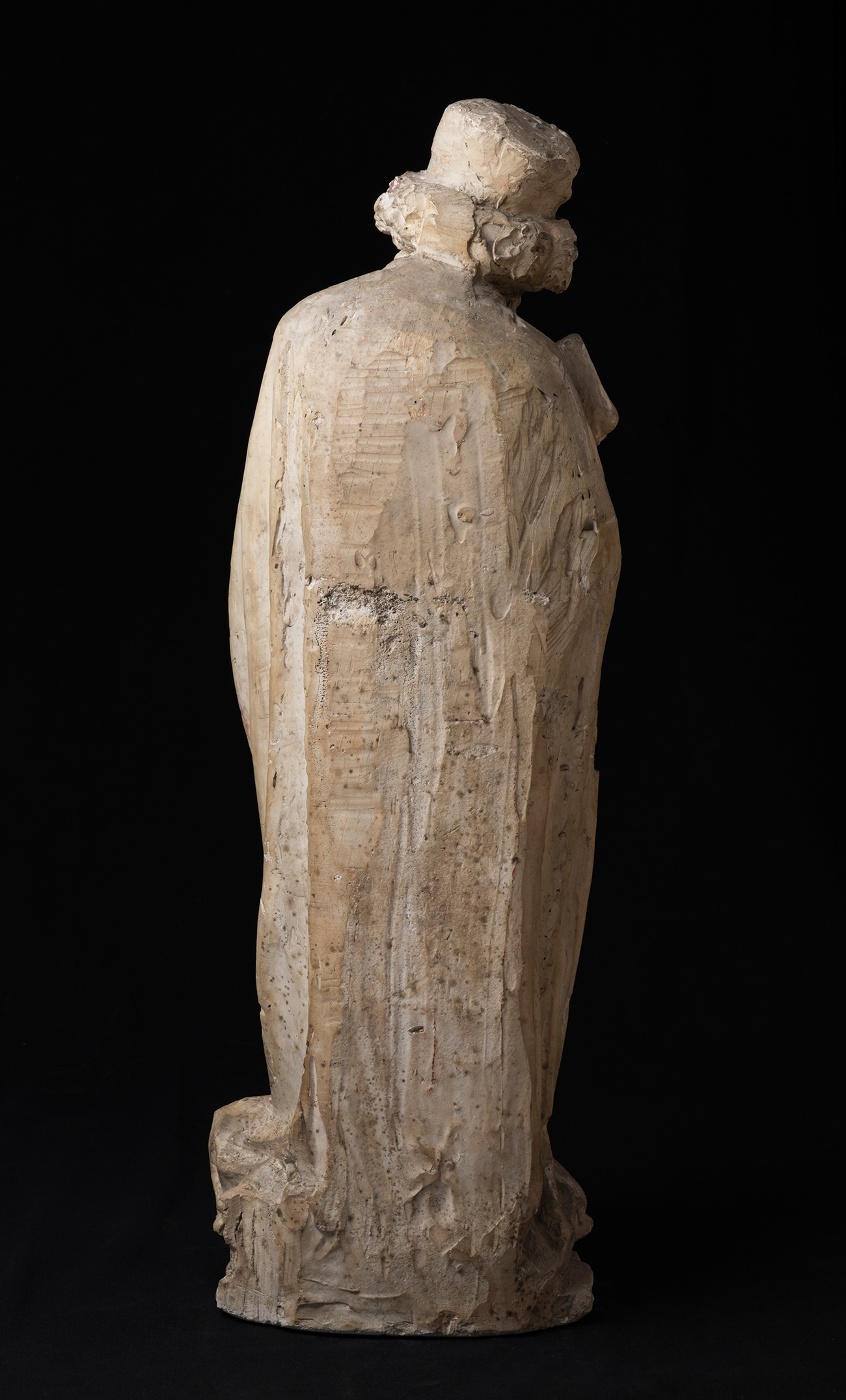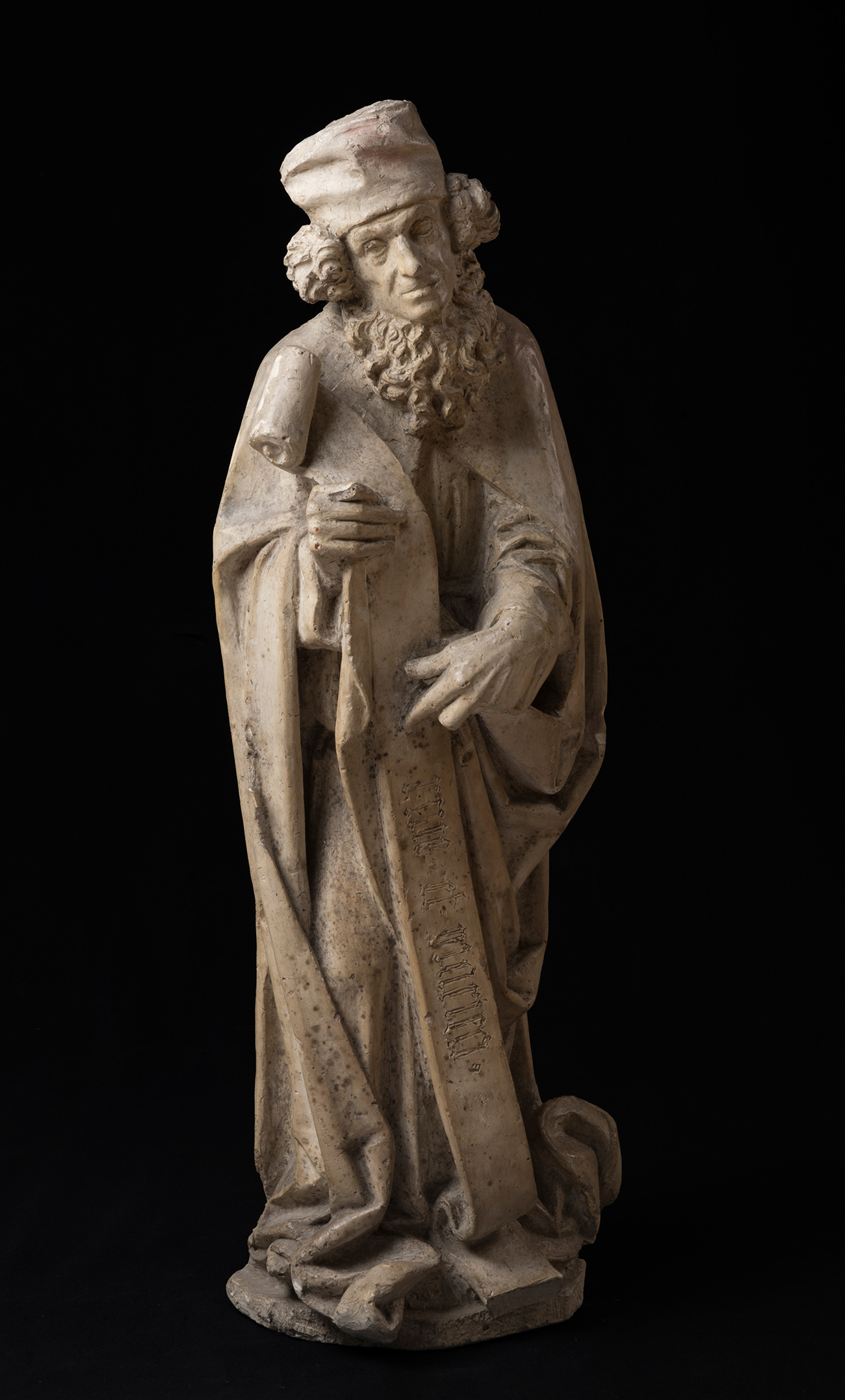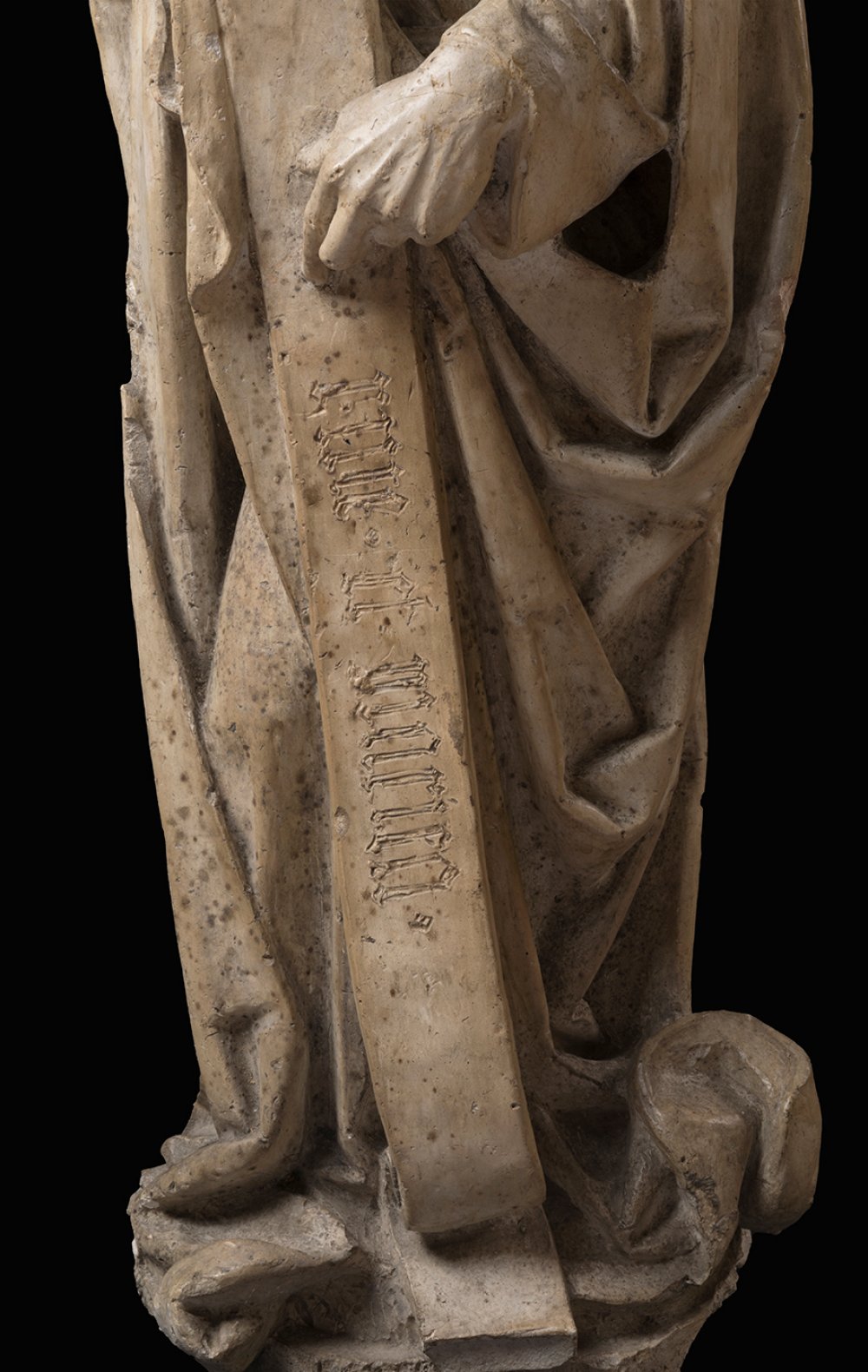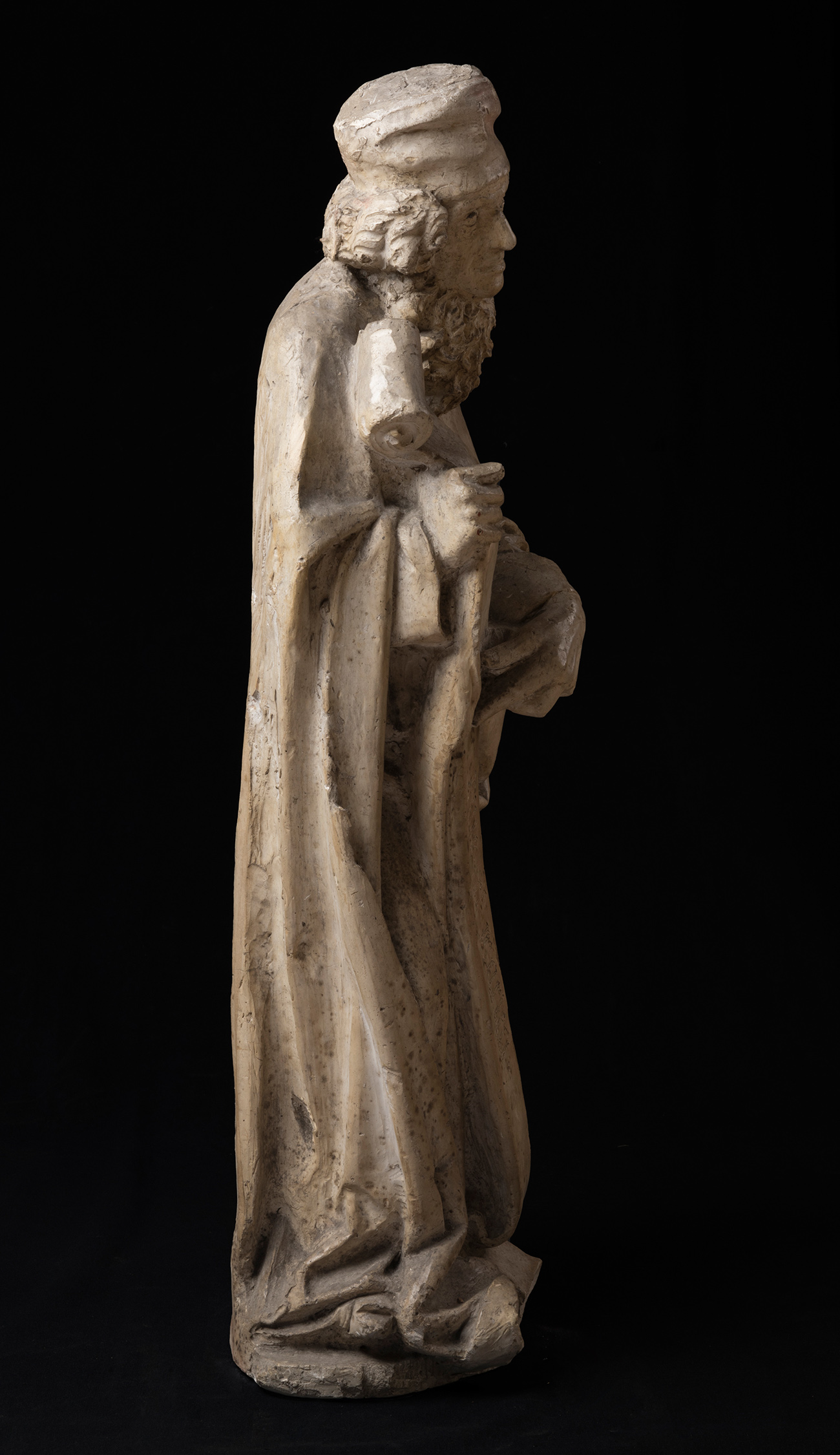9
German school; 15th century."Religious".Stucco.Measurements: 77 x 25 x 16 cm.Round sculpture made of
"Religious".
Stucco.
Measurements: 77 x 25 x 16 cm.
Round sculpture made of carved stucco which presents the figure of an adult man. Both the clothes and the long parchment he is holding in his hand suggest that it is a representation of a religious figure. The quality of the artist is evident in the technical skill shown in the folds of the cloak and the way he manages to place the parchment on the base in a realistic and organic manner. With the arrival of the Gothic period, a substantial aesthetic change took place throughout Europe, both in architecture and in painting and sculpture. The symbolic and timeless hieratism of the Romanesque gave way to a desire for reality and narrative meaning that had its roots in classical sculpture and forced artists to take nature as their model. Gothic sculptors therefore sought to represent the visible world as it is. In this way, the gestures and attitudes of the figures are humanised, and they acquire individuality. Aesthetic conventions - such as the large eyes standing out from the rest of the face, which symbolised the character's soul - were left behind and a naturalistic representation of faces, anatomy, clothing, etc. was sought. Following this new aesthetic line, the figures abandoned their vertical, symmetrical and hieratic postures to adopt increasingly more expressive and gestural ones, with greater realism in their movement. At the same time, an attempt was made to represent the emotions of the figures through eloquent gestures of the face and hands. Gothic art underwent an evolution from the classicism of the 13th century, in which the serene beauty of idealised naturalism was sought, to a certain mannerism of forms that can be seen in the stylisation and elongation of the figures in the 14th century.
Due to its dating, in the 15th century, we can classify this carving as part of the mature Gothic period. With the Proto-Gothic period behind us, the changes in aesthetic mentality became more evident at this time. Symbolic and conventional gestures and representations were left behind, and the artists, who were still anonymous, focused on the naturalistic representation of figures and objects, but above all on expressions and gestures. In Germany, Gothic sculpture appeared around 1220 and its sculpture was subordinated to the façades. In Gothic sculpture, naturalism prevailed, which is evident in this work, perhaps due to its Carolingian heritage, which came to Germany through its links with the Byzantine Empire. German artists formulated a realism that was not always faithful to anatomical reality, although their bodies were extremely dramatic, with elaborate folds of clothing.
"Religious".
Stucco.
Measurements: 77 x 25 x 16 cm.
Round sculpture made of carved stucco which presents the figure of an adult man. Both the clothes and the long parchment he is holding in his hand suggest that it is a representation of a religious figure. The quality of the artist is evident in the technical skill shown in the folds of the cloak and the way he manages to place the parchment on the base in a realistic and organic manner. With the arrival of the Gothic period, a substantial aesthetic change took place throughout Europe, both in architecture and in painting and sculpture. The symbolic and timeless hieratism of the Romanesque gave way to a desire for reality and narrative meaning that had its roots in classical sculpture and forced artists to take nature as their model. Gothic sculptors therefore sought to represent the visible world as it is. In this way, the gestures and attitudes of the figures are humanised, and they acquire individuality. Aesthetic conventions - such as the large eyes standing out from the rest of the face, which symbolised the character's soul - were left behind and a naturalistic representation of faces, anatomy, clothing, etc. was sought. Following this new aesthetic line, the figures abandoned their vertical, symmetrical and hieratic postures to adopt increasingly more expressive and gestural ones, with greater realism in their movement. At the same time, an attempt was made to represent the emotions of the figures through eloquent gestures of the face and hands. Gothic art underwent an evolution from the classicism of the 13th century, in which the serene beauty of idealised naturalism was sought, to a certain mannerism of forms that can be seen in the stylisation and elongation of the figures in the 14th century.
Due to its dating, in the 15th century, we can classify this carving as part of the mature Gothic period. With the Proto-Gothic period behind us, the changes in aesthetic mentality became more evident at this time. Symbolic and conventional gestures and representations were left behind, and the artists, who were still anonymous, focused on the naturalistic representation of figures and objects, but above all on expressions and gestures. In Germany, Gothic sculpture appeared around 1220 and its sculpture was subordinated to the façades. In Gothic sculpture, naturalism prevailed, which is evident in this work, perhaps due to its Carolingian heritage, which came to Germany through its links with the Byzantine Empire. German artists formulated a realism that was not always faithful to anatomical reality, although their bodies were extremely dramatic, with elaborate folds of clothing.
26th October - Old Masters
Sale Date(s)
Venue Address
General delivery information available from the auctioneer
Setdart offers Worldwide shipping
PICK UP IN ROOM: You can come and pick up your lots in our offices (Barcelona, Madrid or Valencia). At the moment of the withdrawal, you will be able to accept the current conditions of the lot by means of a document that you will sign.
YOU CAN SEND ANOTHER PERSON TO PICK UP: This person must present a signed authorization that you can find in our web page by accessing from BUY AT SETDART- LOGISTICS-DOWNLOAD AUTHORIZATION DOCUMENT. You can also send an e-mail with the requested data in AUTHORIZATION DOCUMENT to admin@setdart.com
Important Information
25% buyer´s premium
21% buyer´s premium at www.setdart.com
Terms & Conditions
The maximum period to pay the lots is 7 working days. You can pay either via bank transfer or with credit card through our platform www.setdart.com (we only accept VISA or Mastercard).
BUYER´S PREMIUM: 22% Hammer price + 21% VAT from the buyer´s premium
If your piece has more than 100 years, our Ministry of Culture requires an export certificate in order for the piece to leave the country. Note that if the piece goes inside the EU, there is no cost for the export certificate. If the piece goes outside the EU, there is a cost for the export certificate. You can find more information in our Ministry of Culture website: https://www.culturaydeporte.gob.es/en/cultura/patrimonio/exportacionimportacion/exportacion/tasas.html
INQUIRIES: admin@setdart.com
Setdart guides you through the entire process, from the time of award to the day you receive your lot. Our logistics team will be happy to manage your transport, and will advise you on the best shipping method with professionals from the sector used to handling works of art and jewelry.
WE OFFER WORLDWIDE DOOR TO DOOR SHIPPING
PICK UP IN ROOM: You can come and pick up your lots in our offices. At the moment of the withdrawal, you will be able to accept the current conditions of the lot by means of a document that you will sign.
YOU CAN SEND ANOTHER PERSON TO PICK UP: This person must present a signed authorization that you can find in our web page by accessing from BUY AT SETDART-LOGISTICS-DOWNLOAD AUTHORIZATION DOCUMENT. You can also send an e-mail with the requested data in AUTHORIZATION DOCUMENT to admin@setdart.com
SETDART IS NOT RESPONSIBLE FOR THE STATE OF THE PARTS ONCE THEY LEAVE OUR FACILITIES. MRW SHIPMENTS: Once the payment is made, your lot will be packed for shipment, the logistics department will send you an e-mail notifying you of the day it leaves our warehouse, changes of address cannot be made after receiving this e-mail.
INSURANCE INCIDENTS: Coverage for the value of the auction up to 3000 ? per shipment, if the value of the auction is higher, Setdart will send you a quote including the additional insurance. The insurance company WILL NOT BE RESPONSIBLE FOR THE SHIPMENT THAT EXCEEDS THAT AMOUNT AND IS NOT FULLY INSURED. MRW INCIDENTS: Maximum notification 48 hours after receipt, after which the insurance company WILL NOT BE RESPONSIBLE AND NO CLAIMS WILL BE ACCEPTED.
E-MAIL LOGISTICS: logistica@setdart.com
PICK UP YOUR MESSAGES: You can send your own messaging, prior notice via e-mail that your shipment is ready, please note 3 or 4 days in advance. This type of shipment is packaged so Setdart will provide you with a quote.
EXPENSES FOR STORAGE: We inform you that if the purchased lot is not picked up within a month, you will be charged 30€ per week per lot. Setdart Online S.L., owner of the web site "setdart.com", "setdart.net" and "setdart.org", acts as a company of Spanish nationality inscribed in the Volume 36955, sheet 182, page B-293056 of the Mercantile Registry, with registered office at Calle Aragó













